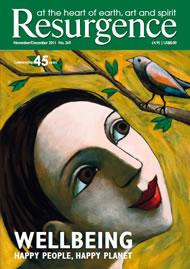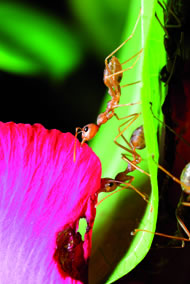Here on Earth explores the crisis of sustainability through the lens of evolution. It offers this in a holistic, Gaian interpretation and argues that all forms and patterns of life on Earth, including human civilisation, are the products of evolutionary process. Very clearly written and highly accessible, this must rank among the best of recent science books written for a general audience.
Tim Flannery starts with the story of Charles Darwin’s insight that more are born than can survive and those best fitted to circumstances will survive and reproduce. Thus over the generations descendants differ from ancestors. This insight was confused by the social prejudices of the time and “even today Darwin’s theory remains mired in confusion and prejudice,” writes Flannery.
He is not, however, convinced by neo-Darwinism and the ‘selfish gene’, stating: “We are far too complex to be comprehended through a reductive dissection of our parts.” But he does take seriously the ‘Medea’ hypothesis, named for the revengeful Medea of Greek mythology, which suggests that the ruthless selfishness required for the survival of the fittest is inevitably a recipe for the elimination of species: if we are too successful we destroy ourselves; the “fittest are merely engines of self-destruction”.
Flannery points out that Darwin was a scientist in the finest reductionist tradition, with an ordered mind and deep patience, interested in the detailed process of evolution, its motive force. One example is his long and systematic studies of earthworms. In comparison, his contemporary the naturalist Alfred Russel Wallace “took on the whole” and attempted to make sense of life on a planetary scale. Wallace realised that while evolution by natural selection is a ruthless process, what it brings about is a deeply interconnected planet. So if competition is the motive force of evolution, then the cooperative world is its legacy. The important heir to this perspective is, of course, James Lovelock’s Gaia theory.
This leads Flannery to a wonderfully clear holistic account of life as process – “living Earthly crust”. Life spends the vast energy budget derived from photosynthesis on increasing diversity and modifying the planet to make it more habitable. He reviews how life impacts on the composition of the atmosphere, temperature regulation, retention of water, movement of continents and other aspects of Gaia theory with which many Resurgence readers will be familiar.
New to me was the suggestion that early life created mineral deposits by mining the oceans for dissolved metals required as catalysts for chemical reactions. New also was the significance of the large herbivores – including the extinct giant kangaroo and woolly mammoth – in increasing ecosystem productivity.
So what is life? Flannery suggests that it is best understood as a “commonwealth of virtue”, self-organising towards increased interdependence. It is not ruthless competition but co-evolution, the development of intricate relationships between unrelated beings that drives later evolution. But humans through cultural evolution and technological development have mimicked and vastly increased the rate of evolution and thus escaped co-evolution’s grip and environmental constraint. From early days, humanity has been a disrupter of ecosystems.
This leads Flannery to discuss ‘superorganisms’. From ant colonies to human culture, superorganisms evolve as entities more competent and productive than the sum of their parts. Accompanying this evolutionary development is a loss of individual competence – none of us would survive long without the accoutrements of our culture.
Here Flannery takes on board the idea of mnemes – transmitted ideas or beliefs – that Richard Dawkins champions. Viewed as complex superorganisms, cultures are held together not only by genetic similarity but also socially by mutual understanding. In our age “mnemes trump genes” in the evolutionary process, so while “we humans may be built by our genes, our civilisations are built from ideas…at the heart of a human superorganism is a mneme – a complex of ideas – about how to use other species for our benefit.”
This extraordinary capacity has led to a devastating impact on the Earthly ecosystem. Early humans ate their way through resources and exterminated species as they spread across the globe. But in addition, humans have an ever-increasing direct impact on the atmosphere and the living fabric of Earth. Flannery documents these in the following three devastating chapters.
He continues to review “our present state” with explorations of population, short-termism, greed and the market, war and inequality. And although I applaud this interdisciplinary approach, I found these excursions into economic and social issues the least satisfying in the whole book, giving a rather cursory review of the issues.
What these chapter do, however, is lead on to Flannery’s central final thesis: how the human superorganism might redeem itself, take part in and even enhance Gaian self-regulation. He argues that in the information revolution we have a significant new toolkit that allows us – through surveillance of the atmosphere, the oceans and the land – to know far more about the state of the planet than we ever did before. Further, the destruction of our global commons thrives on secrecy, and this is a rare commodity when anyone can post information on a website or share pictures taken from a mobile phone. (This is of course the same kind of argument as is made by optimists about the revolutions of the Arab Spring. We will, however, have to wait and see how realistic they actually are.)
Flannery offers an argument for hope: we should not take too small a view of who we are. We are not an unnecessary burden on the planet. By taking a holistic view and understanding that Gaian capacity is built on mutual interdependence, the human superorganism can learn to re-wild the planet, restore the life force and expand Earth’s biocapacity. Information technology and surveillance systems will enable us “to foresee malfunction, instability or other danger, and to act with precision”.
We can again be part of the planet’s self-organising process.
Philosopher Mary Midgley argues the importance of big ideas and of having visions that influence our view of how the world works. Tim Flannery does us a great service in articulating a constructive place for humans in a Gaian future. We will all have different views about the detail, but the overall argument that we are not just determined by selfish genes but can create and share ideas that would lead to a harmonious relationship to the “living Earthly crust” is a strong and powerful one.
My own critique of Here on Earth echoes that of Colin Tudge and his review in The Independent. While welcoming the book, Tudge points out that Flannery is a scientist who really believes that if we all knew the science then all would be well. But while science is important, the necessary shift in worldview needs more than scientific information and theory. It needs us to re-engage with metaphysics, for there is far more to our world than science can tell us.
I think the first steps in such a shift can be found in Stephan Harding’s Animate Earth, in Brian Goodwin’s epistemology of participation, in the late Thomas Berry’s vision of Earth as a community of subjects; these are all aspects of a panpsychic philosophical perspective, which sees the whole of creation as a psychospiritual as well as a material entity.
That this perspective is very difficult for Western-educated people to grasp is a symptom of the depth of materialist assumptions. However, a different philosophy by itself is not sufficient. We also need to find a way not just to know about Gaia but also to experience Gaia, to develop a sense of human identity as part of the whole, taking part in the existence of things, as Keats put it. Keats also told us that ideas had no impact until they were “proved upon our pulses”. We need to draw on art, poetry, drama and experiential education to integrate modern scientific inquiry into a shared panpsychic experience of the interdependence of life on Earth.








